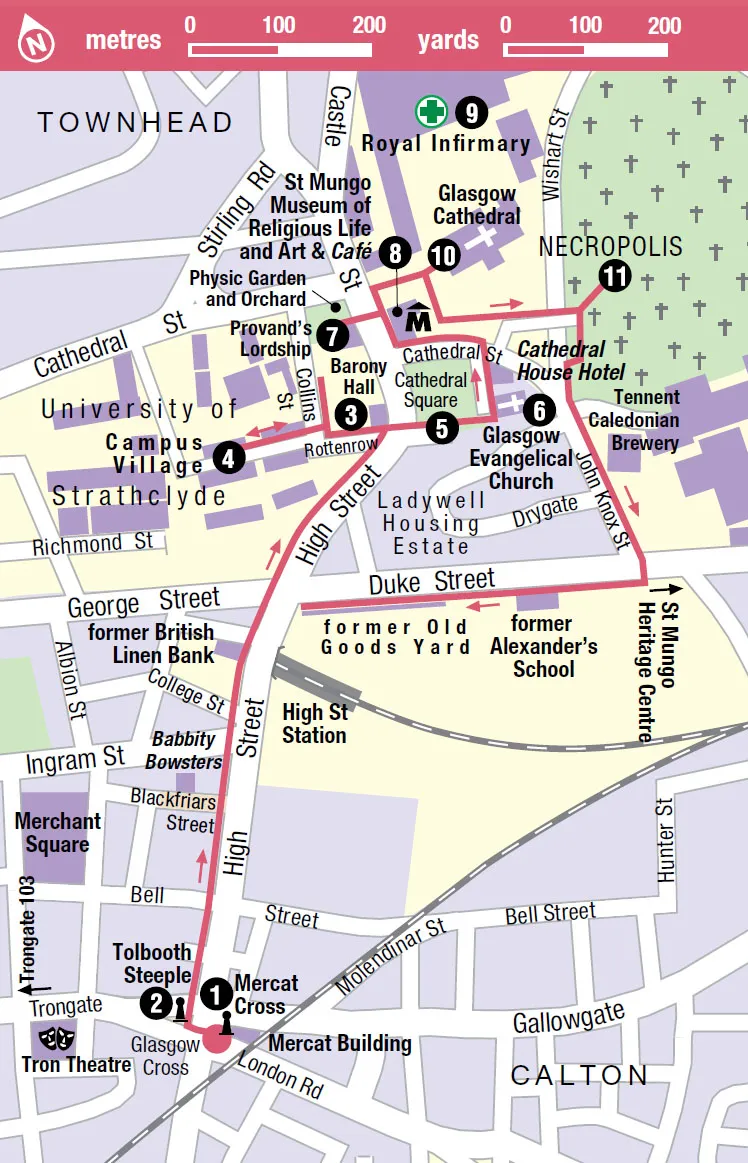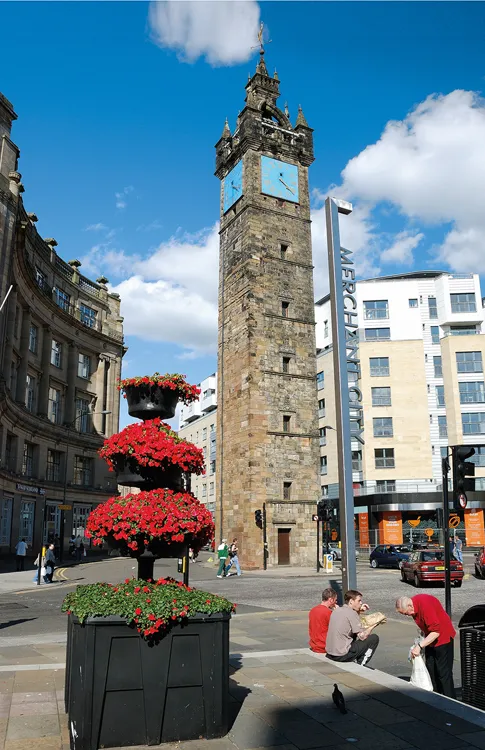Mercat Cross was the visible evidence of a burgh’s right to hold a market, the domain of traders and merchants, making this area Glasgow’s traditional centre of social and economic life for many centuries. There is no clear evidence of exactly where the original Mercat Cross 1 [map] stood, and the squat octagonal building with a unicorn-topped pillar that now stands on the intersection at Glasgow Cross is a replacement erected in 1929. The Mercat Building located behind it is, despite its Chicagoesque appearance, a warehouse erected in 1925. The new arts centre Trongate 103 and the Tron theatre are slowly revitalising this part of the Merchant City area.
Tolbooth steeple
Starting our walk here, the cross is dominated by the Tolbooth Steeple 2 [map], which lies stranded in the middle of busy traffic where the High Street passes into Saltmarket. The Tolbooth was once an integral part of civic life in Glasgow and has occupied this site in various forms since the earliest days. Its functions were manifold, from a meeting place for the town council, to a tax collection point, courthouse and jail.
The Tolbooth Steeple.
Douglas Macgilvray/APA
The square tower was part of a five-storey building which extended west along the Trongate, towards the steeple of Tron-St Mary’s, and its buttressed crown houses the latest of a fine carillon of bells which, in the 18th century, played out a different Scottish melody every two hours. The present bells, installed in 1881, were tended by hereditary bell-ringers, the last of whom, Jessie Herbert, rang the bells until 1970. Their annual high point was, of course, marking the Hogmanay celebrations which saw vast crowds welcoming the New Year in boisterous fashion. The Hogmanay party now takes place in George Square, to the sound of rock bands.
historical high street
The High Street runs north past Victorian tenements (1883), with shops below on the left and new flats converted from old warehouses on the right. The street names offer clues to the past: Blackfriars Street, from the 13th-century Dominican monastery; Bell Street, after Provost Sir John Bell (1680); and College Street, denoting the Old College which was sited here until the middle of the 19th century. The University of Glasgow was established by Bishop William Turnbull in 1451 and flourished for the next few centuries in a pleasant environment between the High Street and the Molendinar Burn. It was here that Adam Smith, author of seminal work on laissez-faire economics The Wealth of Nations, was appointed Professor of Moral Philosophy in 1752.
The university moved westwards in 1870, and the site was sold to the City of Glasgow Union Railway Company, which demolished it and erected the College Goods Station, which has now also gone. However, the area is currently undergoing substantial redevelopment.
On the left, opposite the High Street Station, is the shell of the old British Linen Bank, which has a statue of Pallas, goddess of wisdom and weaving, and a plaque on the corner recalling that the poet Thomas Campbell frequented a coffee shop on the site. Close by, on Nicholas Street, is the Old College Bar, Glasgow’s most ancient pub (est. 1515).
Crossing George Street and curving up the hill, the street is flanked by restored tenements with crow-stepped gables, turrets and balconies. On this hill, the Scots freedom fighter William Wallace – glorified by Hollywood and Mel Gibson in the film Braveheart – fought a running battle with English forces in 1297.
University digs
On the corner of High Street and Rottenrow is Barony Hall 3 [map] (Sat–Sun), the first major building of the Cathedral complex, which opens out onto Castle Street. It was built in 1889 from beautiful red sandstone and graced with slender stained-glass windows and a grey Gothic spire. It is now owned by the University of Strathclyde, and on graduation days the street teems with begowned students and tutors making their way to the hall to receive and bestow degrees. Rottenrow is one of Glasgow’s earliest streets, and its name has never been adequately defined, with suggestions as far apart as route du roi (king’s way) to vicus ratonum (street of rats). It leads to the university’s Campus Village 4 [map], a pleasing and colourful student quarter built over the past two decades, proving that not all modern architecture is unsympathetic.
The Mercat Building on the Trongate.
Douglas Macgilvray/APA
Around cathedral square
Opposite Barony Hall is Cathedral Square 5 [map], guarded by a rather imperious equestrian statue of William of Orange, which was resited by the Provincial Grand Black Chapter of Scotland in 1989 from the Trongate, where it suffered terrible indignities each Hogmanay. It is said that the tail of King Billy’s horse was broken off by a reveller and replaced with a ball and socket joint, with the result that on particularly stormy days, the tail can be seen to wave in the breeze.
On the south side of the square is the 1960s Ladywell housing estate, built over the medieval well of that name and the former Duke Street jail. The east side is bounded by the Glasgow Evangelical Church 6 [map], which features life-sized statues of the Apostles. Just to the north, more worldly pleasures can be found at the Cathedral House, a small hotel housed in a red sandstone building dating from 1896, which has an interesting three-level bar and is reputedly haunted.
The oldest dwelling-house still standing in Glasgow is Provand’s Lordship 7 [map] (tel: 0141-552 8819; www.glasgow...



